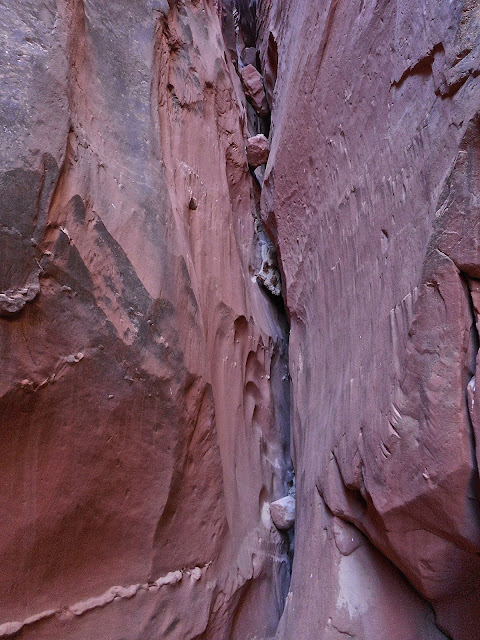JULY 2017
 |
| ALL-AMERICAN MAN PICTOGRAPH AND DWELLING |
 |
| ALL-AMERICAN MAN PETROGLYPH |
 |
| WEDDING RING ARCH |
 |
| FOUR FACES PICTOGRAPH |
 |
| FOUR FACES PICTOGRAPH AND DWELLING |
 |
| FOUR FACES DWELLING |
 |
| KIRKS ARCH |
 |
| GRANARY AND A STILL PRODUCTIVE SQUASH PATCH |
 |
| GRANARIES NEAR THE SQUASH PATCH |
 |
| BIG RUIN |
 |
| NEWSPAPER ROCK |
Salt Creek is a very impressive 19-mile roundtrip hike located near the Needles District which I had never heard of until just a few months prior to visiting in July, 2017. I happened to be in Southern Utah on a Fourth of July weekend, and so I wanted to find a less-popular hike in order to beat the holiday crowds. Salt Creek was perfect, as I had the area entirely to myself. The road to the trailhead was not too rocky, but there were some long sandy sections you will need to be careful on. The trailhead isn't marked, so bring detailed directions.
The trail drops steeply down into the canyon below just past the trailhead. A little after reaching the bottom of the canyon, the trail will fade as you enter a large marshy area overgrown with grasses, rushes and tamarisk trees. You will forget you are in the desert here, as you will be completely immersed in the thick trees, not being able to see very far in any direction. As I was hiking alone, and there was a "Beware of Bears" signs at the trailhead, I got a little nervous in this section as there was bear scat all along the makeshift trail through the marsh.
Eventually the marsh will end and you will enter back into open desert at Kirk's Cabin. There are some ruins a little past Kirk's Cabin, and just past the ruins Kirks Arch will come into view. A little further down the trail there will be 0.8-mile roundtrip spur trail leading to Big Ruin, which is definitely worth your time. As I was day-hiking in some brutal heat, I chose to skip the spur trail to the Big Pocket Ruins to make sure I had the time and energy to make it to the Four Faces Pictograph.
A little past the Big Ruin spur trail there will be a side trail leading to Wedding Ring Arch which is definitely worth your time. A little past Wedding Ring Arch you will see a spur trail leading to some granaries and a squash patch, that is thought to have been planted by the Ancestral Pueblo. Further down the trail you will see a dwelling up in an alcove and then the iconic All-American Man Pictograph. The trail will then take you through a crack between some sandstone cliffs and then drop you into a thick, overgrown marsh with very limited visibility.
Just after exiting the marsh you will come to the Four Faces Pictograph and associated ruins. This area was very impressive. There is also a pond located not too far from the ruins which I was surprised to find salamanders swimming in. It was a beautiful hike, though I may have overestimated my abilities slightly. The heat got to me by the end, and I really struggled making it back up the long steep climb out of the canyon. By the end I was completely out of water and was stopping to rest every couple minutes. While it would be much more pleasant to hike in the Spring or Fall, hiking it in Summer will give you solitude. If I were to do it again, I would either not go quite so far, or backpack it so I could take my time. If you do backpack, you will need to reserve your spot ahead of time with the National Park Service as there are only a few designated sites where it is permitted in the canyon.

















































